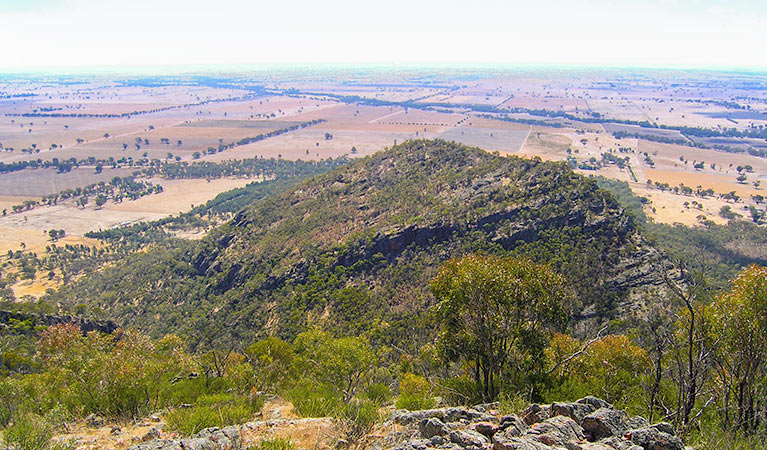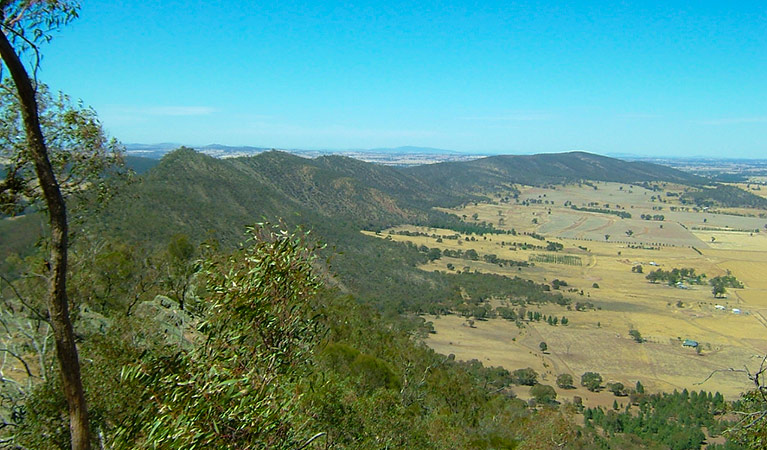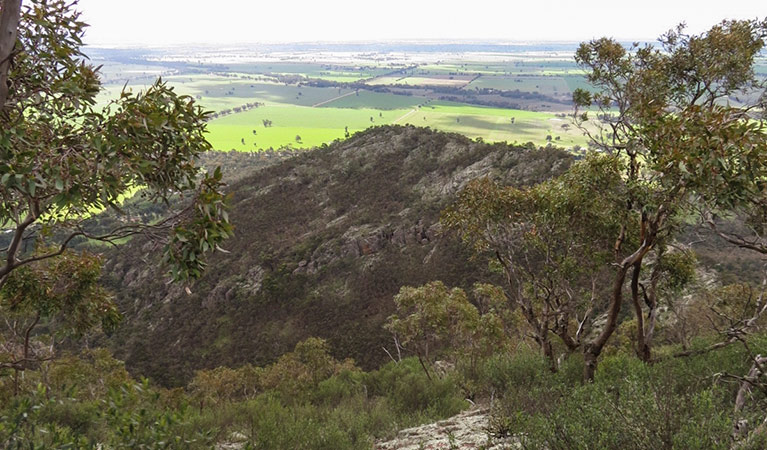The Towers
The Rock Nature Reserve - Kengal Aboriginal Place
Overview
The Towers is a 100m stretch of the north-east face of The Rock, open to rock sports and also popular with photographers and birdwatchers who want to view peregrine falcons.
- Accessibility
- No wheelchair access
- Opening times
- Though this attraction has no specific opening hours, due to safety reasons it is recommended that rock sports are conducted during daylight hours only.
- The Towers are closed to all rock sport activities from 1 July until 31 December each year for the peregrine falcon breeding season.
- What to
bring - Hat, sunscreen, drinking water
- Please note
- Remember to take your binoculars if you want to go birdwatching.
- The weather in this area can be extreme and unpredictable, so please ensure you’re well-prepared for your visit.
- Climbing and abseiling is only recommended for those with prior experience.
- The peregrine falcon breeding season is 1 July until 31 December, and The Towers are closed to rock sports during this time.
The Towers, right near The Rock picnic area, offer a thrilling conquest for rock climbers, abseilers, orienteering groups and photographers alike. Located in The Rock Nature Reserve, the north-east cliff face of The Rock, is a challenge to anybody with experience and the necessary equipment.
Peregrine falcons use The Towers as a nesting sight, offering birdwatchers close-up views of these magnificent creatures. Keep an eye out for peregrines on the cliff and observe their telltale whitewash streaks below their perches.
To reach The Towers, follow a 670m narrow walking trail opposite the picnic shelter and look for the register book. The best time to climb is between January and the end of June. Photographers will love the remarkable view over the surrounding countryside.
Map

Map legend

Local alerts
For the latest updates on fires, closures and other alerts in this area, see https://uat.nswparks.cloud/things-to-do/adventure-sports-experiences/the-towers/local-alerts
Park info
- in The Rock Nature Reserve - Kengal Aboriginal Place in the Murray-Riverina region
The Rock Nature Reserve – Kengal Aboriginal Place is always open but may have to close at times due to poor weather or fire danger.
Visitor info
All the practical information you need to know about The Towers.
Maps and downloads
Learn more
The Towers is in The Rock Nature Reserve - Kengal Aboriginal Place. Here are just some of the reasons why this park is special:
Geological significance

The reserve sits on the boundary between two major biophysical regions: the Riverine Plains and the western slopes of the Eastern Highlands. This geographic mix gives the area a terrific diversity of landscapes and animal habitats. The Rock itself, unique in the district, is the result of a pressure uplift of sedimentary materials, and is the highest point of a hogback ridge running north to south (The Rock is at the northern end). The summit stands 364m above the surrounding plains.
- Aboriginal special places guided tours Join Bundyi Cultural Tours in The Rock Nature Reserve - Kengal Aboriginal Place, near Wagga Wagga to explore ancient Wiradjuri culture in a beautiful and timeless landscape.
- The Towers The Towers is a 100m stretch of the north-east face of The Rock, open to rock sports and also popular with photographers and birdwatchers who want to view peregrine falcons.
Living Aboriginal culture: Kengal

The dual name of the nature reserve (since 2005) acknowledges a Wiradjuri cultural presence that stretches back many generations. The Rock is also known as Kengal (meaning ‘sloping hill’), a Dreaming place, lookout, and ceremonial site for the Wiradjuri People and their descendants. It was once used for male initiation rituals. Traditional lore has it that Kengal was created by Baiame, the creator who also taught the Wiradjuri People how to make fire and spears. When settlers arrived in the area, stories go, Baiame left his male and female dingo (Mirrigan) companions, who lay in wait for Baiame’s return, forming The Rock.
- Aboriginal special places guided tours Join Bundyi Cultural Tours in The Rock Nature Reserve - Kengal Aboriginal Place, near Wagga Wagga to explore ancient Wiradjuri culture in a beautiful and timeless landscape.
'The Hanging Rock’

Charles Sturt first saw The Rock in 1829, though the area wasn’t settled further by Europeans until 1874. They called the remarkable geological feature ‘The Hanging Rock’ because of an overhang on its eastern face. This collapsed in 1874, however, leading to the adoption of its current name – simply, ‘The Rock’. For much of its modern life, the feature has sat on Crown land, and from 1891 its lower slopes were quarried for road base material to provide ballast on a Sydney-Melbourne rail line.

